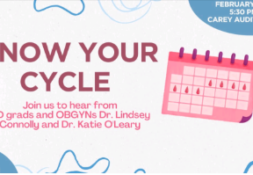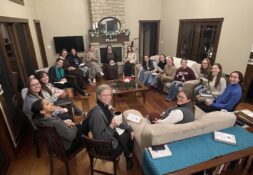World-renowned novelist and poet Margaret Atwood teaches Notre Dame students the power of storytelling
In my Literature and Ecology class last semester, we read Margaret Atwood’s dystopian novel, Oryx and Crake. The day after we started reading the book, we came into class prepared to discuss it. Before anyone spoke, a biology major in my class said, “Can I just say … she’s brilliant!”
This made it apparent that Atwood’s writing could appeal to people from all walks of life, not just those who particularly love literature. After watching an audience of more than 100 professors, undergraduates and members of the South Bend community listen to this quick-witted woman speak for an hour on storytelling, I realized that her rhetoric perfectly matched the broad appeal of her writing.
English Professor Matthew Wilkens tells the Rover, “I thought that this talk was very well pitched for a general audience. The audience included folks who just love books, faculty, aspiring creative writers, and more. I thought she had a nice way of appealing to as many of those groups as possible.”
Atwood created an inclusive environment right away, stating: “Ladies, gentlemen, and Twitter followers.” She then implored those who were standing in the back to “come forward” and sit on the stage so that they could hear her better.
One of the students she beckoned forth was Victoria Drazdik, a sophomore architecture major. Drazdik later told the Rover, “I was really impressed with her dry wit. I expected a thoughtful talk, and I received that, but I was also entertained. It was also cool how everybody there was collectively ‘geeking out’ over Margaret Atwood.”
Atwood recounted how she grew up listening to her mother tell stories to her, her brother and all the neighborhood kids.
“There was no television in those days, so if you wanted entertainment on our street in Sault Ste. Marie in 1945, my mother was pretty much it,” she said.
She told the audience how she later became the storyteller in the family, reciting bone-chilling horror stories to her younger sister and friends at birthday parties. “There are now a number of sixty plus women roaming the Earth who have vastly enriched their psychoanalysts with accounts of their irrational terrors,” Atwood remarked.
Margaret Doody, the John and Barbara Glynn Family Professor of Literature, tells the Rover, “She [Atwood] wants to anchor everything to the experience of the living world.”
Senior English major Michelle Werner comments, “The most interesting part for me was the way that storytelling has always been a part of her life. From her mom spinning a yarn for all the neighborhood kids to her own birthday party business to her becoming a famous author, she was constantly weaving together worlds for the enjoyment of others.”
Being a Canadian herself, Atwood carefully selected her words for a story about our neighbors to the North: “Despite their innocuous, benign, and at times soporific exteriors, their hearts are made of solid, ten-thousand-year-old glacial ice, and they can transform themselves at will into bears, or, even more threateningly, into hockey players.”
She used this description of Canadians to give audience members tips about storytelling, such as to include strange wonders, to make your yarn as plausible as possible, and to “put in some naked people.”
Atwood went on to explain what writing means to her: “Writing is writing down. It’s a score for voice—pieces of text that the reader plays or interprets in the same way that musical scores are pieces of written symbols that musicians can play, thus turning some black marks on the page into music.”
John Sitter, the Mary Lee Duda Professor of Literature, tells the Rover, “I think she’s very good at giving what seems very casual information that turns out to be fairly sophisticated, and connecting personal anecdotes with larger themes about storytelling.”
Sophomore English major Kate Broadbent agrees: “I loved how she explained storytelling by telling stories of her own and interweaving personal anecdotes.”
Before the question and answer portion, Atwood ended her lecture by saying that “writing down a story is always a gesture of hope. Why? Because you’re assuming that there will be someone alive who will be interested in it and who will read it later in time. That is a truly hopeful thing.”
Perhaps her most striking answer was to the audience question, “Why do you write?” She answered simply, “Because I am a human being, and human beings tell stories.”
Wilkens tells the Rover that this answer was one of his favorite parts of the lecture. He says, “I suppose that’s an obvious answer on one hand, but it is a true answer, and I think it speaks to why many of us are interested in literature. How could we not be? This is an important part of what it means to have an interesting, worthwhile life.”
Along with teaching them to never trust a Canadian, Atwood also taught audience members how storytelling can be taught only through actual storytelling, one of the greatest appeals to someone’s humanity.
As Heffron put it, “Her talk on storytelling became a story in and of itself, and I love that!”
Caroline Corsones is a sophomore English major with a minor in secondary education. If you need to find her over the next couple of months, she will be voraciously reading all of Margaret Atwood’s books. Contact her at ccorsone@nd.edu.






Leave a Reply